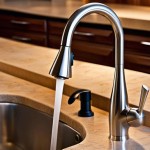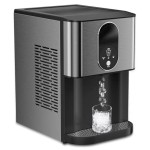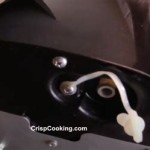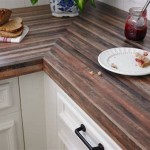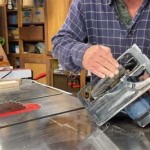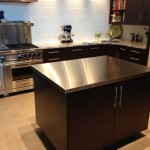How To Declutter Kitchen Countertops
Kitchen countertops often become catch-all surfaces, accumulating items that range from daily essentials to rarely used appliances. This accumulation can lead to a cluttered, visually unappealing, and functionally inefficient kitchen space. A decluttered countertop, on the other hand, offers a cleaner, more organized, and more inviting environment for food preparation and other kitchen activities. This article provides a comprehensive guide on how to effectively declutter kitchen countertops, focusing on practical strategies and sustainable habits to maintain a tidy and functional space.
Evaluating and Prioritizing Items
The initial step in decluttering involves a thorough evaluation of all items currently residing on the countertops. This process requires a critical assessment of each object's necessity and frequency of use. Items should be categorized into several groups: essentials used daily, items used occasionally, items that can be stored elsewhere, and items that are no longer needed or desired.
Essential items are those used multiple times a day and are crucial for daily kitchen tasks. Examples include coffee makers, toasters, or frequently used utensils. The frequency of use is the primary determinant for classifying an item as essential. If an item is used daily or almost daily, it warrants a prominent position on the countertop, provided it is appropriately sized and organized.
Items used occasionally, such as blenders, food processors, or specialized cooking tools, require a different approach. These items, while useful, do not necessitate constant accessibility. They can be stored in cabinets, drawers, or pantries, readily available when needed but not occupying valuable countertop space when not in use. The key is to designate a specific storage location for each item, ensuring easy retrieval and preventing future countertop clutter.
The third category encompasses items that can be stored elsewhere in the house or even eliminated altogether. This includes items that have migrated from other rooms and items that are duplicates or no longer serve their intended purpose. For instance, mail, books, or decorative items that have found their way onto the countertop should be returned to their appropriate locations. Similarly, duplicate kitchen tools or appliances that are seldom used should be considered for donation or disposal.
Finally, items that are no longer needed or desired should be promptly discarded or donated. Broken appliances, expired food items, and unwanted kitchen gadgets only contribute to clutter and should be removed from the kitchen environment. A ruthless approach to eliminating unnecessary items is essential for achieving a truly decluttered countertop.
During this evaluation process, it is beneficial to take a realistic assessment of personal habits and kitchen usage patterns. Identifying the primary activities that occur on the countertop helps to determine which items are genuinely essential and which are merely convenient. For example, if baking is a frequent activity, storing essential baking tools within easy reach might be justified. Conversely, if baking is a rare occurrence, storing those tools in a less accessible location would be more appropriate.
Optimizing Storage Solutions
Effective storage solutions are critical for maintaining a decluttered kitchen countertop. The goal is to maximize the use of existing storage spaces, such as cabinets, drawers, and pantries, while also exploring innovative storage options to accommodate all necessary kitchen items. Thoughtful organization within these storage spaces is as important as the spaces themselves.
Cabinets and drawers should be organized according to frequency of use and item type. Items used most frequently should be stored within easy reach, while less frequently used items can be placed on higher shelves or in the back of drawers. Using dividers, organizers, and tiered shelves can significantly improve the efficiency of cabinet and drawer space. These tools help to maximize vertical space and prevent items from becoming disorganized and difficult to locate.
Pantries offer valuable storage space for non-perishable food items, small appliances, and other kitchen essentials. A well-organized pantry can significantly reduce countertop clutter by providing designated storage locations for items that would otherwise end up on the countertop. Using clear containers to store dry goods, labeling shelves, and implementing a first-in, first-out system can help to maintain an organized and efficient pantry.
In addition to traditional storage spaces, consider utilizing vertical space to further optimize storage solutions. Wall-mounted shelves, hanging racks, and magnetic knife strips can free up valuable countertop space by providing alternative storage locations for frequently used items. These solutions are particularly useful for storing utensils, spices, and cutting boards. Furthermore, under-cabinet lighting can enhance visibility and functionality in these areas.
Countertop organizers, such as utensil holders, knife blocks, and spice racks, can also contribute to a decluttered countertop, provided they are carefully selected and appropriately sized. Choosing organizers that are both functional and aesthetically pleasing can help to maintain a cohesive and organized kitchen environment. However, it is crucial to avoid over-organizing, as too many organizers can also contribute to clutter.
Portable islands or carts can provide additional countertop and storage space in smaller kitchens. These mobile units can be easily moved around the kitchen to accommodate different tasks and can be stored away when not in use. They offer valuable surface area for food preparation and can also provide additional storage for kitchen appliances and utensils.
Consider investing in storage solutions that match the aesthetic of the kitchen. This can help to create a cohesive and visually appealing space. Uniform containers and organizers can contribute to a sense of order and can make the kitchen feel more spacious and organized.
Establishing and Maintaining Sustainable Habits
Decluttering kitchen countertops is an ongoing process that requires establishing and maintaining sustainable habits. A one-time decluttering effort will only provide temporary relief if new habits are not implemented to prevent future clutter. These habits should focus on preventing accumulation, regularly tidying up, and consistently evaluating the necessity of items on the countertop.
One of the most effective ways to prevent countertop clutter is to immediately put away items after use. This simple habit prevents items from accumulating on the countertop and reduces the time and effort required for future decluttering sessions. Washing dishes immediately after meals, storing ingredients after cooking, and returning appliances to their designated storage locations after use are all essential components of this habit.
Regularly tidying up the countertops is also crucial for maintaining a decluttered space. A quick daily wipe-down can prevent spills and crumbs from accumulating and can help to maintain a clean and inviting kitchen environment. In addition, taking a few minutes each day to put away any stray items can prevent clutter from building up over time. This daily tidying routine can be integrated into the existing kitchen routine, making it a seamless and sustainable habit.
Consistently evaluating the necessity of items on the countertop is another important aspect of maintaining a decluttered space. Regularly assess whether each item is still being used frequently and whether it is still contributing to the functionality and aesthetics of the kitchen. If an item is no longer needed or desired, it should be promptly removed from the countertop and either stored elsewhere, donated, or discarded.
Avoid using the countertop as a temporary storage space for items that belong elsewhere. This habit can quickly lead to clutter and can disrupt the overall organization of the kitchen. Establish designated storage locations for all items and consistently return them to their proper places after use. This will prevent items from accumulating on the countertop and will help to maintain a decluttered and organized space.
Involve all members of the household in the effort to maintain a decluttered kitchen countertop. Establishing clear expectations and assigning responsibilities can help to ensure that everyone is contributing to the upkeep of the kitchen. This may involve assigning specific tasks, such as washing dishes, putting away groceries, or tidying up the countertop after meals.
Periodically conduct a more thorough decluttering session to reassess the organization of the kitchen and to eliminate any accumulated clutter. This session can be conducted on a weekly or monthly basis, depending on the frequency of kitchen use and the tendency for clutter to accumulate. During this session, evaluate all items on the countertop, in cabinets, and in drawers to ensure that they are still needed and that they are being stored in the most efficient manner.
By establishing and maintaining these sustainable habits, it is possible to create and maintain a decluttered kitchen countertop that is both functional and aesthetically pleasing. A decluttered countertop not only enhances the visual appeal of the kitchen but also improves its functionality and efficiency, making food preparation and other kitchen activities more enjoyable.

How To Declutter Your Kitchen Counters Like A Pro

How To Declutter Kitchen Counters Quickly The Savvy Sparrow

How To Declutter Kitchen Counters Make It A Habit

How To Quickly Declutter Kitchen Counters For Good

Declutter Your Countertops In 15 Minutes Simplyput Organizers

Steps For Decluttering Your Kitchen Counters Budget Dumpster

11 Clever Ways To Declutter Kitchen Counters Grillo Designs

Kitchen Declutter Steps For A Minimalist Katieskottage

Decluttering Kitchen Counters And Keep Them Clutter Free

How To Declutter Kitchen Counters Make It A Habit
See Also


